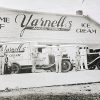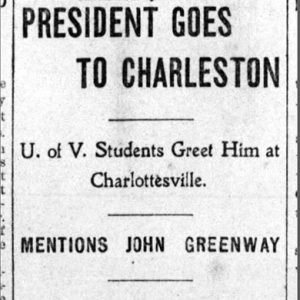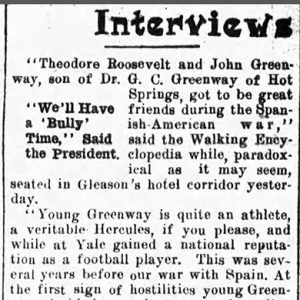calsfoundation@cals.org
John Campbell Greenway (1872–1926)
John Campbell Greenway was well known for his developments in the mining industry and was also one of a handful of soldiers with Arkansas connections to serve with Theodore Roosevelt’s Rough Riders, First Volunteer Cavalry, in the Spanish-American War.
John Greenway was born in Huntsville, Alabama, on July 6, 1872, to Dr. Gilbert Christian Greenway and Alice White Greenway. He had four brothers and one sister.
When he was a young child, his family moved to Hot Springs (Garland County). He lived there long enough to complete grade school in the city’s public school system. At that time, his family moved to Alexandria, Virginia. He continued his education, graduating from Alexandria’s Episcopal High School. He then attended Andover Academy in Andover, Massachusetts, and the University of Virginia before enrolling in the Sheffield Scientific School at Yale University. While at Yale, he excelled in both athletics and academics. He starred on both the university football and baseball teams, won All-American honors two years in a row for his baseball skills, and was elected senior class president. He was also a member of Phi Kappa Psi and the Society of Book and Snake. He graduated with an engineering degree in 1895.
After a post-graduation European trip, he took a job with Carnegie Steel Company in Duquesne, Pennsylvania, where he worked for about three years before war broke out with Spain in 1898. By the time he left for the military, he had risen to the position of mechanical department foreman.
During the Spanish-American War, he served as a volunteer with Theodore Roosevelt’s famous Rough Riders. He was cited for bravery at the Battle of San Juan Hill and was reported to have been the second soldier to reach its summit. By the end of the war, he had been promoted to brevet captain. Roosevelt described him as “a strapping fellow, entirely fearless.”
Upon conclusion of the war, he returned to Carnegie and accepted the job of assistant superintendent for the U.S. Steel Corporation mines at Ishpeming, Michigan. When Carnegie purchased holdings in Minnesota, Greenway became general superintendent of the operations in the Mesabi Range in 1906. While there, he became an important factor in the development of the town of Coleraine. During his career, he was also instrumental in the development of the towns of Marble and Taconite, Minnesota; Ajo, Arizona; and Los Lamentos and Chihuahua, Mexico.
In 1910, he became general manager of the Calumet and Arizona Cooper Company in Bisbee, Arizona. At that time, he was also the general manager of the New Cornelia Cooper Company, vice president and general manager of the Cornelia and Gila Bend Railway, and vice president of the Ahumada Lead Company.
After a visit to Ajo, he opened a new copper mine there. Once again, he was deeply involved in the development of a town where he would make his home.
In 1917, Greenway was involved in a major labor controversy, instituting what became known as the Bisbee Deportations. When members of the Industrial Workers of the World (IWW) called a strike in the mines in 1917, he petitioned the local sheriff to gather up and transport any workers on strike to a desolate area near the Mexican border. Greenway was indicted for violation of the workers’ civil rights. Though he was acquitted, the incident damaged his reputation.
When the United States entered World War I in 1917, Greenway volunteered and was commissioned a major in the U.S. Army Corps of Engineers. Serving with the First and Twenty-Sixth Divisions, he rose to the rank of lieutenant colonel of the 101st Infantry. He saw active service on the European front and was awarded the Distinguished Service Cross and the Croix de Guerre, among other honors. After the war, he was commissioned a brigadier general in the U.S. Army Reserves.
On November 4, 1923, he married Isabella Selmes Ferguson, who was fourteen years his junior. Isabella was the widow of Greenway’s Rough Rider comrade Robert Ferguson, who died in 1922. The couple had a son, John Selmes Greenway.
In the summer of 1925, Greenway retired from the Calumet mines.
Politically, Greenway had been an active supporter of Roosevelt’s Progressive Party campaign for president in 1912, serving as a presidential elector from Arizona. Though later returning to the Republican Party, he had become a Democrat by the early 1920s. During the 1924 Democratic National Convention, his name was placed in nomination for vice president, but his own political ambitions never seemed to move past the planning stages.
On a visit to Washington DC to lobby Congress for a dam project, he was diagnosed with a large gallstone. Following a recommended surgery by his doctor in New York City, complications developed. On January 19, 1926, a few days after surgery, he died from a blood clot in the lung. He was initially buried in Ajo. In 1995, following the death of his son, Greenway’s body was disinterred and moved to Belleview, Kentucky, where his remains were reburied in his wife’s family cemetery. In later life, Isabella Greenway served two terms representing Kentucky in the U.S. House of Representatives.
In 1930, Greenway was honored as one of two Arizona dignitaries to have their statue placed in Statuary Hall in the Capitol Building in Washington DC. His statue remained there until it was replaced with one of Senator Barry Goldwater in 2015. His statue now stands in the Polly Rosenbaum Archives and History Building near the Arizona State Capitol. In 2015, he was inducted into the National Mining Hall of Fame.
For additional information:
Boice, Donald, John C. Greenway and the Opening of the Western Mesabi. Itasca, IL: Itasca Community College Foundation, 1975.
“John Campbell Greenway.” National Mining Hall of Fame and Museum. https://mininghalloffame.org/page/john-campbell-greenway (accessed February 8, 2020).
Roosevelt, Theodore. The Rough Riders. New York: Charles Scribner’s Sons, 1899.
Debra Polston
Cabot, Arkansas



 Greenway Rough Riders Mention
Greenway Rough Riders Mention  Roosevelt Interview Article
Roosevelt Interview Article 



Comments
No comments on this entry yet.